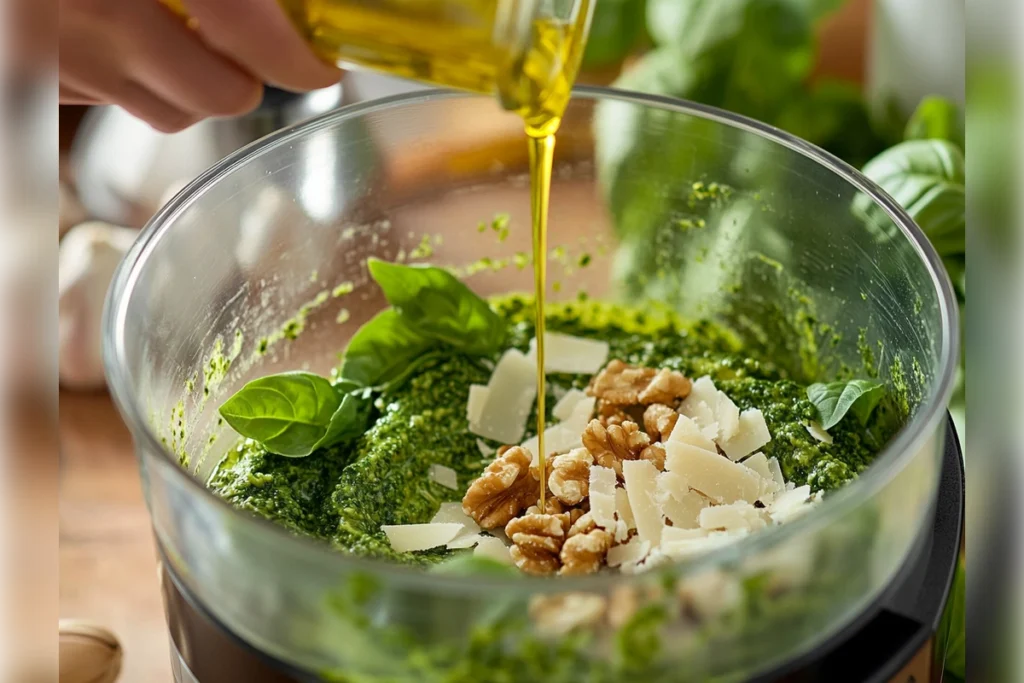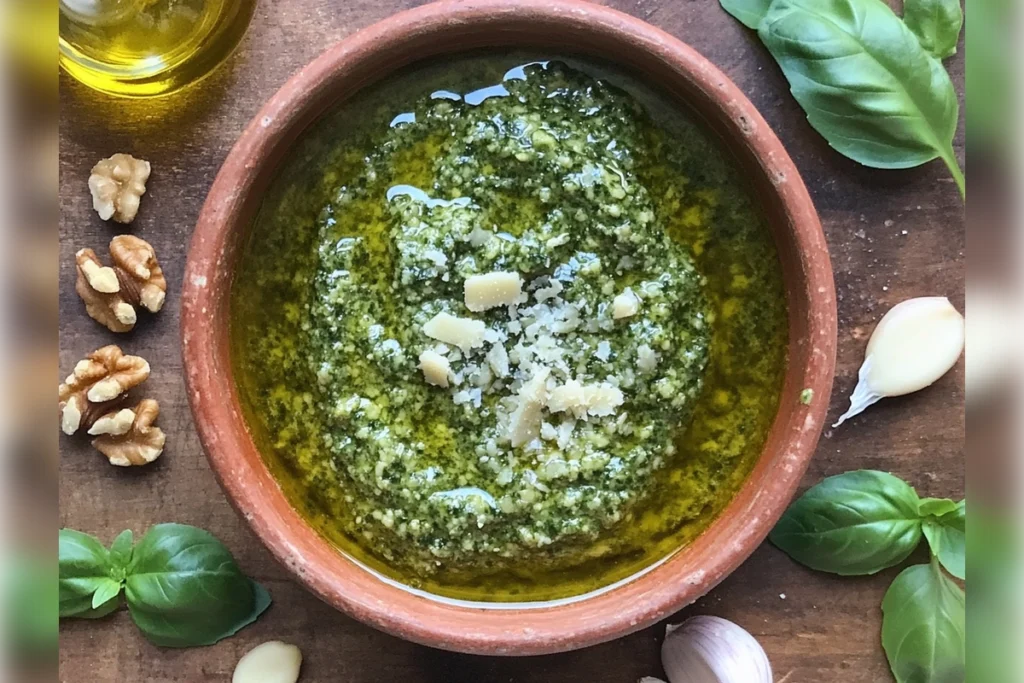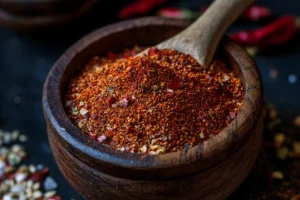Introduction
If you’re craving a sauce that’s vibrant, aromatic, and packed with flavor, you’re in the right place. The basil walnut pesto recipe is not just a sauce it’s a versatile kitchen hero that can transform pasta, sandwiches, and grilled meats into gourmet delights. Unlike traditional pesto made with pine nuts, this version features walnuts, offering a richer, earthier flavor while being easier on your wallet.
In this guide, we’ll dive into everything you need to know about this delicious pesto variation. From understanding its origins to mastering the perfect recipe and exploring creative uses, this article has it all. Whether you’re a pesto newbie or a seasoned sauce maker, you’ll find practical tips, step-by-step instructions, and plenty of inspiration to elevate your culinary game. Ready to dive in? Let’s start with an introduction to the basil walnut pesto recipe.
Introduction to Basil Walnut Pesto
What is Basil Walnut Pesto?
At its core, basil walnut pesto is a fresh, vibrant sauce made from basil leaves, walnuts, garlic, Parmesan cheese, and olive oil. Originating from the Italian “pesto alla Genovese,” this variation swaps out pine nuts for walnuts—a nutty twist that adds depth and complexity. It’s a creamy, bright green sauce that pairs well with everything from pasta to grilled vegetables.
The beauty of pesto lies in its simplicity. With just a handful of ingredients and a trusty food processor, you can whip up a fresh batch in minutes. And while store-bought pesto might seem convenient, homemade pesto has a fresher taste and allows you to control the quality of each ingredient.
Why Choose Walnuts Over Pine Nuts in Pesto?
Pine nuts have long been the traditional choice for pesto. However, they come with a hefty price tag and can sometimes be difficult to find. Enter walnuts: they’re more affordable, widely available, and offer a delicious, slightly bitter flavor that perfectly complements the sweetness of basil.
Plus, walnuts are packed with omega-3 fatty acids, making them a healthier choice without compromising on taste. Whether you’re trying to cut costs or simply experimenting, basil walnut pesto proves that walnuts are more than just a substitute—they’re an upgrade.
The Popularity of Basil Walnut Pesto Around the World
While pesto is undeniably Italian, its popularity has spread worldwide, becoming a staple in many kitchens. From Italy’s pasta al pesto to American sandwiches and global fusion dishes, this sauce transcends borders.
In recent years, food enthusiasts have embraced basil walnut pesto as a modern twist on the classic. Its affordability, combined with its bold flavor profile, has made it a favorite among home cooks and professional chefs alike. Whether served on pasta, spread on crusty bread, or drizzled over grilled chicken, this pesto continues to win hearts globally.
Stay tuned as we dive deeper into the essential ingredients for crafting the perfect basil walnut pesto recipe in the next section. Ready your taste buds—it’s going to be delicious! 🍃🌰
Essential Ingredients for Basil Walnut Pesto
When it comes to crafting the perfect basil walnut pesto recipe, the quality of your ingredients plays a crucial role. Each component contributes a unique flavor and texture, and choosing the best ingredients ensures your pesto is fresh, aromatic, and delicious.
Fresh Basil: The Star Ingredient
At the heart of every basil walnut pesto recipe is fresh, vibrant basil. These fragrant leaves provide the classic green color and unmistakable aroma that make pesto a kitchen favorite. For optimal results, use freshly harvested basil, preferably from your garden or a local farmer’s market.
- Tip: Avoid washing basil leaves under strong water pressure. Instead, gently rinse them and pat them dry with a kitchen towel to prevent bruising.
Walnuts: A Nutty Alternative to Pine Nuts
Walnuts are the hero of this recipe, offering a rich, slightly bitter flavor profile. Beyond their delicious taste, they’re also more affordable and readily available compared to pine nuts. Toasting them lightly before blending enhances their nutty richness.
- Tip: Toast walnuts in a skillet over medium heat for about 3–5 minutes until golden brown and fragrant.
Olive Oil: The Liquid Gold of Pesto
High-quality extra-virgin olive oil binds all the ingredients together, creating a smooth, creamy texture. It also adds a mild fruity note that balances the basil and walnut flavors.
- Tip: Use cold-pressed olive oil for the best flavor and nutritional benefits.
Parmesan Cheese: Adding Depth and Flavor
Parmesan cheese brings a salty, umami richness to your basil walnut pesto recipe. Freshly grated Parmesan is always better than pre-packaged alternatives, as it blends seamlessly into the pesto.
- Alternative: For a vegan version, nutritional yeast can replace Parmesan cheese.
Garlic: Raw vs. Roasted Garlic in Pesto
Garlic is a small but mighty player in pesto. While raw garlic provides a sharp kick, roasted garlic offers a mellow sweetness. Choose based on your flavor preference.
- Tip: If raw garlic is too sharp for your taste, roast the cloves in a skillet for a softer, caramelized flavor.
Ingredient Table
| Ingredient | Quantity | Purpose |
|---|---|---|
| Fresh Basil | 2 cups | Provides aroma and color |
| Walnuts | 1/4 cup | Adds nuttiness and texture |
| Olive Oil | 1/2 cup | Creates smooth consistency |
| Parmesan Cheese | 1/4 cup grated | Adds savory richness |
| Garlic | 2-3 cloves | Adds bold flavor |
| Salt & Pepper | To taste | Enhances overall taste |
Step-by-Step Guide to Making Basil Walnut Pesto

Now that we’ve covered the essential ingredients, it’s time to put them together. Making pesto is simple, but attention to detail ensures the perfect consistency and flavor.
Preparing Your Ingredients
Start by gathering and measuring all your ingredients. Fresh basil, toasted walnuts, grated Parmesan, and garlic should be ready to go.
- Rinse and pat dry your basil leaves to prevent browning.
- Toast the walnuts to enhance their flavor.
- Grate the Parmesan cheese finely for smooth blending.
Having everything prepped ensures a smooth process.
Using a Food Processor: Tips and Tricks
The food processor is your best friend for creating pesto. Follow these steps for the best results:
- Add basil, walnuts, Parmesan, and garlic to the food processor.
- Pulse the mixture a few times until coarsely chopped.
- With the motor running, slowly drizzle the olive oil through the feed tube.
This gradual addition helps create a creamy texture without breaking down the basil too much.
Drizzling Olive Oil for the Perfect Texture
Olive oil isn’t just a binder—it also determines the texture of your pesto. Drizzle it slowly to achieve a silky, smooth sauce.
- Tip: Avoid adding all the olive oil at once; it can lead to separation.
Seasoning: Balancing Salt and Pepper
Once blended, season your pesto with salt and pepper. Taste and adjust as needed. Remember, Parmesan adds saltiness, so don’t overdo it initially.
- Optional: Add a squeeze of lemon juice for a zesty twist.
Common Mistakes to Avoid When Making Pesto
- Over-processing the basil: This can turn the pesto bitter.
- Using too much garlic: Start small and taste as you go.
- Skipping toasting the walnuts: Toasted nuts add a richer depth of flavor.
By avoiding these pitfalls, your basil walnut pesto recipe will turn out delicious every time.
For more inspiration, consider pairing your pesto with pasta dishes like this Cherry Tomato Pasta Guide.
Variations of Basil Walnut Pesto
One of the best things about the basil walnut pesto recipe is its versatility. With a few tweaks and substitutions, you can create exciting variations to suit different dietary needs and flavor preferences. Whether you’re exploring vegan options, craving a spicy kick, or experimenting with other greens, there’s a version of pesto for everyone.
Kale and Basil Walnut Pesto
If you want to add an extra nutritional punch to your basil walnut pesto recipe, kale is a fantastic addition. Kale not only enhances the pesto’s earthy flavor but also adds a boost of vitamins and minerals.
- How to make it: Replace half of the basil with fresh kale leaves. Remove the tough stems and blanch the kale briefly to reduce bitterness.
- Best for: Spreading on sandwiches, mixing into pasta, or using as a pizza sauce.
This version is perfect for those who want a slightly heartier and nutrient-dense pesto.
Vegan Basil Walnut Pesto
Traditional pesto contains Parmesan cheese, but creating a vegan basil walnut pesto recipe is surprisingly easy. Nutritional yeast is the perfect substitute, adding a cheesy flavor without any dairy.
- How to make it: Swap out Parmesan cheese for 3 tablespoons of nutritional yeast.
- Best for: Vegan pasta dishes, dipping sauces, or spreading over roasted vegetables.
This variation ensures that everyone at your table can enjoy the vibrant flavors of pesto.
Spicy Basil Walnut Pesto
If you love a little heat, this variation will quickly become your favorite. Adding a pinch of red pepper flakes elevates the flavors without overpowering the fresh basil and nutty walnuts.
- How to make it: Add ¼ teaspoon (or more) of crushed red pepper flakes while blending your pesto.
- Best for: Spicy pasta dishes, grilled meats, or as a zesty sandwich spread.
The spicy kick makes it an excellent choice for adding bold flavor to your meals.
Nut-Free Alternatives
If you have a nut allergy or simply want to try something different, seeds can be an excellent substitute. Sunflower seeds and pumpkin seeds both work well in place of walnuts.
- How to make it: Replace walnuts with an equal amount of toasted sunflower seeds or pumpkin seeds.
- Best for: Allergy-friendly pesto recipes, kids’ meals, or school lunches.
For another creative sauce idea, check out this guide on Tomato Gravy Recipes. It’s another versatile addition to your kitchen repertoire!
These variations prove that pesto isn’t just a one-size-fits-all recipe. In the next section, we’ll dive into delicious ways to serve your basil walnut pesto recipe. Get ready for some mouthwatering ideas!
Delicious Dishes Using Basil Walnut Pesto
Your freshly made basil walnut pesto recipe isn’t just for pasta—it’s a versatile sauce that can enhance a variety of dishes. From grilled meats to warm bread, pesto adds flavor, vibrancy, and a touch of sophistication to almost anything.
Pasta with Basil Walnut Pesto
The classic way to enjoy basil walnut pesto is by tossing it with pasta. This dish is not only quick and easy but also incredibly satisfying.
- How to make it: Cook your favorite pasta (like spaghetti, penne, or fusilli). Reserve some pasta water, then toss the hot pasta with the pesto and a splash of reserved water for a silky texture.
- Optional additions: Grilled chicken, cherry tomatoes, or roasted vegetables.
This dish is perfect for a weeknight dinner or a special occasion.
Pesto-Stuffed Chicken Breast
Take your chicken dinner to the next level by stuffing it with basil walnut pesto. This recipe creates a flavorful and juicy chicken breast that pairs beautifully with rice or salad.
- How to make it: Butterfly a chicken breast, spread pesto inside, and secure it with toothpicks. Bake until golden and cooked through.
- Serving suggestion: Serve with a fresh salad or creamy mashed potatoes.
For more chicken inspiration, you might enjoy this Baked Chicken Cutlet Recipe Guide.
Pesto Cheese Bread
Transform ordinary bread into something extraordinary with basil walnut pesto. It’s perfect as an appetizer or alongside pasta dishes.
- How to make it: Slice a loaf of bread lengthwise, spread a thick layer of pesto, sprinkle shredded mozzarella or Parmesan cheese, and bake until bubbly.
- Best served with: Soups, salads, or as a snack.
This cheesy delight is hard to resist!
Grilled Vegetables with Pesto Drizzle
Vegetables love pesto, and a drizzle of basil walnut pesto recipe over grilled veggies takes them to the next level.
- How to make it: Grill vegetables like zucchini, bell peppers, and eggplant. Once cooked, drizzle them with pesto before serving.
- Best for: Barbecue sides, healthy meals, or vegan plates.
The pesto adds a burst of fresh flavor that makes even the simplest vegetables shine.
These are just a few of the many ways you can use your basil walnut pesto recipe. Whether you’re tossing it with pasta, stuffing it into chicken, or drizzling it over vegetables, this sauce is your kitchen superhero.
For more creative recipe ideas, check out our Pasta Lemon Butter Basil Recipe. It’s another excellent way to use pesto in your cooking adventures.
ghtful sauce and why it’s more than just a tasty topping.
Health Benefits of Basil Walnut Pesto
The basil walnut pesto recipe isn’t just a flavor powerhouse—it’s also packed with health benefits. Made with fresh basil, heart-healthy walnuts, and olive oil, this sauce is a nutritious addition to your meals. Let’s explore how each ingredient contributes to your well-being.
Nutritional Benefits of Basil
Basil isn’t just a fragrant herb; it’s also loaded with essential nutrients and antioxidants. Some key benefits of basil include:
- Rich in vitamins: Basil contains vitamins A, K, and C, which support eye health, immunity, and skin vitality.
- Anti-inflammatory properties: Basil contains compounds like eugenol that help reduce inflammation.
- Natural detoxifier: Basil helps cleanse the liver and eliminate toxins from the body.
Adding basil through your basil walnut pesto recipe is an easy way to include this super herb in your diet.
Why Walnuts Are a Superfood
Walnuts are considered one of the healthiest nuts around, and they bring more than just great flavor to your basil walnut pesto recipe. Here’s why:
- Heart health: Walnuts are rich in omega-3 fatty acids, which are essential for heart health.
- Brain booster: The antioxidants and healthy fats in walnuts support cognitive function.
- Good for digestion: They are a good source of fiber, aiding in better digestion.
With just a handful of walnuts in your pesto, you’re boosting your body with essential nutrients and healthy fats.
Is Basil Walnut Pesto Healthy?
Absolutely! The basil walnut pesto recipe combines wholesome, natural ingredients that are both nutritious and delicious. Here’s why pesto is a healthy choice:
- Healthy fats: Olive oil and walnuts provide heart-healthy unsaturated fats.
- Low-carb and keto-friendly: Pesto is naturally low in carbs, making it perfect for low-carb diets.
- Nutrient-dense: With basil, garlic, and Parmesan, every spoonful is packed with vitamins and minerals.
However, it’s important to keep portion sizes in check, as pesto can be calorie-dense due to olive oil and nuts.
Tip: Use pesto as a flavor booster rather than drenching your dishes in it. A little goes a long way!




1 thought on “The Ultimate Guide to Crafting a Delicious Basil Walnut Pesto Recipe”